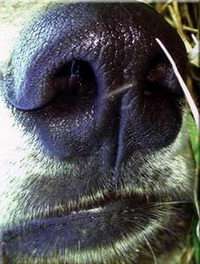Study shows a fundamental difference between how insects, mammals detect odors

When smelling their favorite foods, both humans and insects usually go with their instinct and try to find the source. However, according to new research by Leslie Vosshall and colleagues at Rockefeller University, when it comes to smell, that’s about the only thing that they have in common.
Vosshall and colleagues have found that, contrary to current theory, the molecular basis of insect olfaction is not related to the mammalian system, but is an extraordinary case of the two types of organisms evolving along similar, but separate, lines — what scientists term convergent evolution. Through detailed analysis of the proteins involved in odor detection in fruit flies, the researchers found that instead of looking similar to odorant receptors in mammals, the fruit fly proteins define a completely new, insect-specific, receptor family — opening the door to the development of novel insect repellents that could shut down mosquitoes’ ability to smell without interfering with humans.
It all started with flies that couldn’t smell. Superficially, the sense of smell in flies and mammals is very much alike, since both have numerous olfactory sensory neurons, found in the nose in mammals, and in the antennae in flies. These neurons express proteins, called odorant receptors, which detect smells in the air. However, previous research in flies by Vosshall and colleagues identified one odorant receptor, called OR83b, expressed in all olfactory sensory neurons. And when OR83b is taken away, the fly can’t smell anything because none of the other odorant receptors make it to the cell surface.
“The requirement for one odorant receptor, OR83b, acting in the detection of many odors is very unusual,” says Richard Benton, a postdoc in Vosshall’s lab and first author of the paper. “This led us to think that OR83b must be doing something important with the other receptors, but exactly what it was doing was unclear. Using the genetic trickery available in fruit flies, we began to address this question in the sensory neurons themselves.”
Benton and colleagues found that when OR83b is not expressed, the other receptors never make it out of the endoplasmic reticulum, the cellular structure in which they are made. When OR83b is put back into the neurons, however, the other odorant receptors can now localize to the sensory cilia, where they are exposed to odor molecules, and stay there as long as OR83b continues to be expressed. As soon as OR83b is taken away again, the receptors start disappearing.
“You first need OR83b to get the other receptors to the sensory cilia,” says Benton. “But it is also required to maintain them in the sensory membranes.” However, OR83b doesn’t need any of the other odorant receptors to get to the membrane. It’s special, which indicated to Benton and his colleagues that it must link the other receptors to the protein trafficking pathway.
To determine which parts of the receptors mediate these interactions, they did some computational analysis of the receptor protein sequences. Their results confirmed what had already been known, that these proteins spanned the cell membrane. But this analysis led to a surprising discovery: that the proteins looked nothing like G-protein coupled receptors, which are the odorant receptors in mice and humans.
“Stemming from mammalian work in the late 1980s, the whole focus in this field was on odorant receptors being G-protein coupled receptors.” Benton says. “It has always been assumed that the fly’s olfactory system worked the exact same way. However, our analysis implied that mouse and fly receptors looked nothing like each other because the fly proteins have a different orientation in the membrane. This was intriguing and stimulated us to test experimentally this computational prediction.”
Their molecular tests confirmed that OR83b, as well as the other odorant receptors in flies, are positioned in the membrane in the opposite way to mouse odorant receptors. The results indicate that insect odorant receptors define a completely novel family of transmembrane proteins.
“This is exciting as it raises a lot of questions,” says Benton. “The whole focus in the field was that these were G-protein coupled receptors, based on the work done in mice. Our data changes the way we think about how insects smell, because it appears that they have evolved a completely different molecular solution to the problem of odor detection.”
Source: Rockefeller University

















